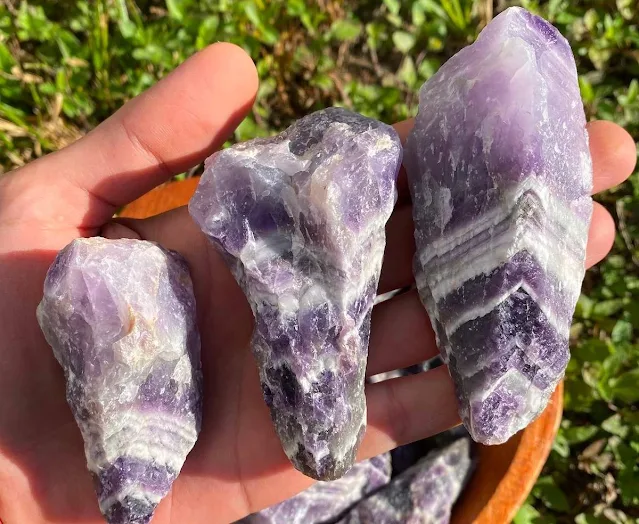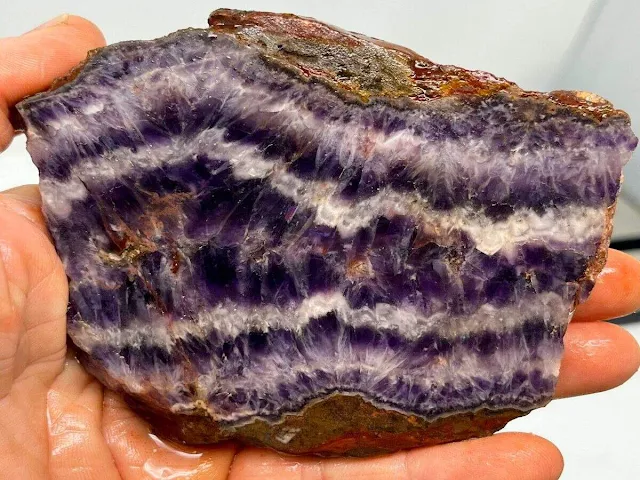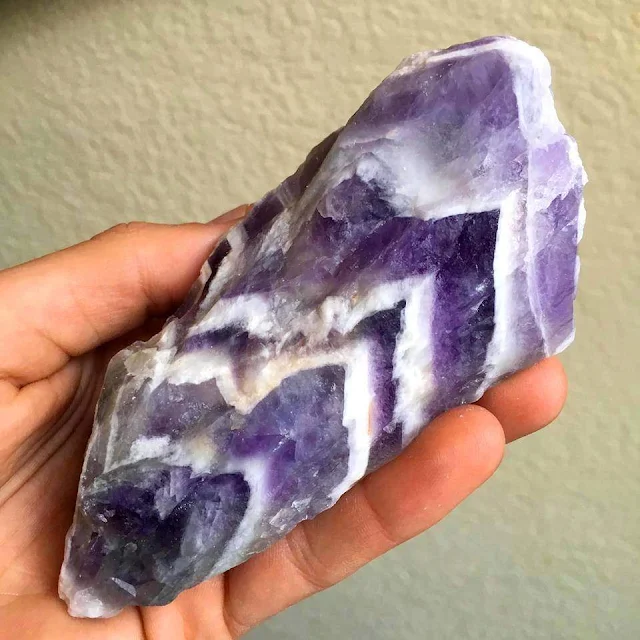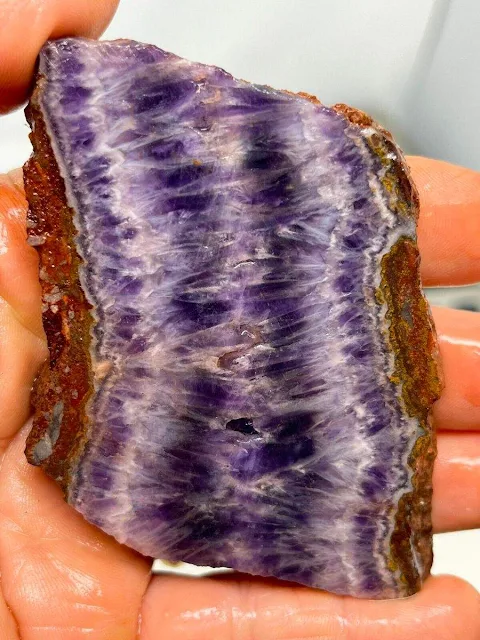Chevron Amethyst: Properties, Uses, Occurrence
Chevron Amethyst is a naturally occurring variety of Amethyst that features distinct V-shaped or chevron patterns of white Quartz running through its purple base. It's rarer than regular Amethyst.
Chevron Amethyst, formally identified as banded amethyst or dog-tooth amethyst, comprises intergrown layers of microcrystalline quartz (SiO₂) and macrocrystalline amethyst, a variety of quartz containing trace amounts of iron (Fe³⁺) responsible for its characteristic purple coloration.
Some Chevron Amethyst specimens exhibit a phenomenon called "chatoyancy," where a shimmering line moves across the surface when tilted under light.
Chevron Amethyst typically originates in hydrothermal veins or cavities within igneous and metamorphic rock formations.
Its name derives from the Greek "a-methystos," meaning "not drunk," reflecting the belief it could prevent intoxication and promote clear thinking. The "Chevron" comes from the V-shaped pattern resembling the chevron symbol used in military and other contexts.
 |
| Chevron Amethyst slab. Photo: Orlando Gemstones |
Properties of Chevron Amethyst
Composition: Primarily silicon dioxide (SiO₂) with trace amounts of iron (Fe) and other minerals, contributing to its color and banding.
Color: Varies depending on the concentration and distribution of iron within the crystal. Typically, it features alternating bands of purple (amethyst) and white (quartz). The purple can range from lavender to deep violet, and the white can have subtle variations like milky or smoky tones.
Luster: Vitreous, meaning glassy and reflective.
Crystal System: Trigonal, with six-sided hexagonal prisms and pyramids as common crystal forms.
Streak: White, as the amethyst and quartz components both leave a white streak when scratched against a hard surface.
Hardness: 7 on the Mohs scale of mineral hardness, indicating it can scratch most other minerals except for harder ones like diamond, corundum, and topaz.
Cleavage: Poorly defined, with occasional fractures occurring along the basal planes.
Crystal Form: Can form in various shapes, including prismatic crystals, druzy clusters, and massive formations.
Density: Approximately 2.65 g/cm³, slightly denser than pure quartz due to the presence of iron in the amethyst component.
Transparency: Can range from translucent to nearly transparent depending on the crystal thickness and clarity.
Fracture: Conchoidal, meaning it breaks with curved, shell-like fractures rather than clean breaks along cleavage planes.
Specific Gravity: 2.65 - 2.68, slightly higher than pure quartz due to the denser amethyst component.
Solubility: Insoluble in water and most common acids, but can be slowly dissolved by strong alkalis.
Magnetism: Non-magnetic.
Fluorescence: Can exhibit weak fluorescence under longwave ultraviolet light, sometimes with a pink or orange glow.
Pleochroism: Weak, with slight variations in color intensity depending on the viewing angle.
Refractive Index: 1.553 - 1.583, slightly higher than pure quartz due to the denser amethyst component.
Inclusions: May contain internal inclusions like tiny needles of rutile or other minerals, adding to its unique character and visual interest.
 |
| Chevron Amethyst rough |
Formation of Chevron Amethyst
Chevron Amethyst typically originates in hydrothermal veins or cavities within igneous and metamorphic rock formations. Unlike most Amethysts, Chevron forms not just from iron but also from
fluctuating temperature and fluid composition within veins, creating
its distinct layered appearance.
Here's a breakdown of its formation:
Hydrothermal Veins: It all starts with cracks or fissures in rocks, often formed by volcanic or tectonic activity. These cracks become pathways for silica-rich fluids (hot water with dissolved silica) to travel through the Earth's crust.
Crystallization: As the fluid cools within these veins, the dissolved silica starts to crystallize. The specific conditions determine the type of quartz that forms. In the case of Chevron Amethyst, it's typically a combination of Amethyst (purple due to iron impurities) and white Quartz (pure silica).
Banding Patterns: The distinctive chevron pattern with alternating white and purple bands arises due to fluctuations in the fluid's composition and temperature. These variations affect the concentration of iron and other color-causing elements, leading to distinct layers of Amethyst and Quartz.
Growth Stages: The banding patterns can be simple with few layers or complex with intricate V-shapes. This depends on the duration and frequency of changes in the fluid composition and temperature during crystal growth.
Completion: Eventually, the vein completely fills up with crystallized quartz, sealing the formation of Chevron Amethyst. Depending on the environment, it might be further polished by natural processes like erosion and weathering.
 |
| Chevron Amethyst. Photo: Orlando Gemstones |
Where to Find Chevron Amethyst
Several locations around the globe boast Chevron Amethyst deposits, each with its unique characteristics:
Brazil: The largest deposits and some of the most stunning Chevron Amethyst specimens come from Brazil, specifically states like Rio Grande do Sul and Bahia.
India: India is another significant source, with notable mines in Maharashtra and Madhya Pradesh. Indian Chevron Amethyst often exhibits a softer color palette, with lavender and milky white bands.
Madagascar: Smaller deposits of Chevron Amethyst can be found in Madagascar, known for its unique color variations and patterns.
Russia: Ural Mountains in Russia yield Chevron Amethyst with a deep purple hue and well-defined bands.
Namibia: This African country offers unique Chevron Amethyst with intricate patterns and sometimes a smoky quartz element.
It's important to note that the specific characteristics of Chevron Amethyst can vary depending on the location, with differences in color intensity, banding patterns, and presence of other minerals.
Uses and Applications of Chevron Amethyst
Chevron Amethyst's uses are as diverse as its beauty and energy. Here's a breakdown of its applications:
Jewelry
Rings, necklaces, bracelets, earrings: Chevron Amethyst's stunning V-shaped patterns and vibrant colors make it a captivating choice for jewelry, adding a touch of elegance and spiritual significance.
Gemstone carvings: Skilled artisans can carve Chevron Amethyst into intricate figures, pendants, or other decorative pieces, showcasing its unique beauty and symbolic meaning.
Home and Decor
Decorative objects: Beautiful Chevron Amethyst specimens can be displayed as sculptures, geodes, or polished stones, adding a touch of natural beauty and spiritual significance to any space.
Metaphysical and Spiritual
Meditation and spiritual practices: Chevron Amethyst is believed to enhance focus, clarity, and connection to higher realms, making it a popular stone for meditation, prayer, and spiritual rituals.
Chakra balancing: The combination of Amethyst and Quartz in Chevron Amethyst is said to balance the Third Eye and Crown Chakras, promoting intuition, spiritual awareness, and inner peace.
Protection and grounding: Chevron Amethyst is believed to offer protection from negativity and help one stay grounded in the present moment, making it a valuable companion during challenging times.
 |
| Chevron Amethyst Pendant |
Healing and Wellness
Stress relief and relaxation: The calming and soothing energy of Chevron Amethyst is said to promote relaxation, reduce anxiety, and ease mental stress.
Physical healing: Some believe Chevron Amethyst can aid in pain relief, strengthen the immune system, and even support recovery from addiction.
Sleep improvement: Placing Chevron Amethyst under your pillow is believed to promote restful sleep and vivid dreams, enhancing dream recall and lucidity.
 |
| Chevron Amethyst, banded Amethyst and white Quartz together. Credit: Daniel Virgadaula |
Conclusion
Chevron Amethyst transcends its captivating beauty to offer a glimpse into the fascinating world of mineral science. Its unique composition, banding pattern, and physical properties make it a compelling subject for scientific inquiry, while its diverse applications underscore its cultural and technological significance.
Read also:
Amethyst - Formation, Properties, Uses
Amethyst Stalactites
The Giant Amethyst Geodes in Uruguay
Amethyst Color: How Amethyst Changes Color



%20(1).webp)





